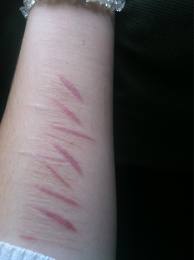Scars come in a wide variety of patterns that often identify the cause of the original injury. One of the most identifiable scar patterns is that from cutting. Most commonly seen on the arms, cutting is a form of self-mutilation that is almost exclusively seen in teenagers and young men and women. Using sharp objects such as razor blades and knives, self-harm is done by making a series of superficial to medium-depth skin cuts on the arms or legs. Psychologists state that this behavior is an outward expression of inward torment and even suicidal thoughts. Clearly it is self-destructive behavior.
What was once a very rare scar pattern for a plastic surgeon to see, it is now becoming more common. According to recent estimates in the U.S., one in every 200 teenage girls between ages 13 and 19 have cut themselves…a rather startling statistic even if it is only a half percent. More females do this behavior than men in a 60:40 ratio and my experience confirms that with more young females seen.

The revision options for most scars almost exclusively include excision and laser resurfacing. But cutter scars can not really be improved by either. The scars are usually too fine to result in much change by excision and re-closure. Even if a few of the bigger ones can be improved by being narrowed, that does little to change the look of the overall scar pattern. Laser resurfacing seems like such an obvious method of improvement but it is not as simple as wiping the scars away. Laser resurfacing only goes so deep but never as deep as the scar tissue. Even though the scar may appear fine line, they go all the way into the dermis. No matter how many of the top layers of the skin that are removed by the laser, it just unmasks more of the scar.
What does work for cutter arm scars if traditional methods of scar revision will not? I have found only two methods that can change the entire look of most or all of the scar area. These are dramatic scar treatment methods that are not appropriate for most patients, but for the right person they may be acceptable. One approach is a full-thickness excision of the scarred area and replacement with a thick split-thickness skin graft. This will leave an eventual patch appearance but that certainly changes the way it looks and is more explainable to public scrutiny. (I had an injury and needed a skin graft) The other approach is to use the laser to create a deep burn over the area. This will replace all the fine line scars with one large hypertrophic burn scar. This creates a lot more scar but does offer another more explainable injury pattern.
Both treatment approaches certainly do remove the emotional and psychological memories of the cutter scars…even if their replacements would be judged as ‘worse’ scars.
Dr. Barry Eppley
Indianapolis, Indiana


